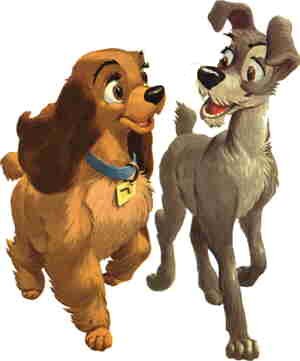| … if not necessarily traditional ones passed down orally from generation to generation; whereas in Lady & the Tramp, the only fantasy element was that the dogs, cats, beavers etc. could talk to one another (but not to humans).
Lady & the Tramp was also the first not based on a published story. While in the case of Dumbo, the story had achieved only limited distribution before Disney got hold of it, Lady & the Tramp actually originated within the Disney organization. It started, possibly as early as the 1930s, with a scenario crafted by Ward Greene, later editor of King Features Syndicate (and co-creator of Rip Kirby), about a love affair between a disreputable mutt called Happy Dan the Whistling Dog (seen in a short story by Greene), and the prim and proper Miss Patsy the Beautiful Spaniel.
But Walt, a stickler for impeccable story values even over his famously high production values, shelved it until it could be developed to his standards. Evidence of the long time it spent before going into actual production is found in one of the live-action scenes in The Reluctant Dragon (1941) taking place inside the Disney studios, where materials from Lady & the Tramp can be seen in the background.
Pre-publicity for the movie's impending release included a novelization by Greene, published in 1953. Post-release adaptations included a comic book by Dell, later reprinted by Gold Key, and a Sunday comics feature as part of the series Walt Disney's Treasury of Classic Tales. Dell also published a few later adventures of the main characters.
This was also the first Disney feature made in the wide-screen format that became popular in the '50s, trademarked under the name "Cinemascope". In fact, whereas earlier films were generally made with an aspect ratio of 1.33 (that is, 1.33 times as big across as they were up-and-down), this one had an aspect ratio of 2.55, making it the broadest of all Disney animated features, before or since. This allowed animators to move the characters across the screen, rather than simulate motion by moving the backgrounds.
Yet another "first" was that Disney was sued by actress/singer Peggy Lee, voice of Peg, one of the dogs Lady met while incarcerated in the pound, for a share of the money Disney made, starting in 1987, from its release to home video, on grounds that her contract didn't cover videotape. She eventually collected a seven-figure sum, prompting later Disney talent contracts to include rights in "media not yet invented".
Narration of the film took place from Lady's point of view, meaning the only names the principal humans in her life had were what she heard them call each other, Jim Dear and Darling. Lee voiced Darling as well as the Siamese cats Si and Am, in addition to Peg. Her voice was also heard in one of the George Pal Puppetoons that starred Jasper. Jim Dear was Lee Millar, otherwise a face actor, but who is probably best known for this role. Lady herself was Barbara Luddy (Kanga (no relation) in Disney's early Winnie the Pooh shorts) and Tramp was Larry Roberts, who wasn't known for other acting roles.
The villain in the story, the well-meaning but sorely misguided human, Aunt Sarah, was voiced by Verna Felton, who also played Pearl Slaghoople in The Flintstones. Lady's neighbor dog, Jock, was Bill Thompson (Droopy); and her other neighbor, Trusty, was Bill Baucom, who also lacks other voice credits. Other dogs' voices included Alan Reed (Big Bill in Shinbone Alley), Dal McKennon (Archie) and Thurl Ravenscroft (Tony the Tiger). The beaver in the zoo was Stan Freberg (Joonyer Bear). The dog catcher who was foiled at the end in his attempt to take Tramp away was, like Jim Dear, voiced by Lee Millar.
Only one character was successfully spun off from Lady & the Tramp, and he didn't even have a name in the movie. In the final scene, the pair had four puppies, three of whom took after their mother in both looks and behavior. The one that was just like his father was later marketed as Scamp. He was the star of the straight-to-video sequel, Lady & the Tramp II: Scamp's Adventure, which came out in 2001.
This film's initial acceptance was fairly cool, but critics have since come around to the point of view that it's one of Disney's most heart-warming features. In fact, the famous scene where Lady and Tramp eat a plate of spaghetti together is regarded as perhaps the most romantic in all of Disney's animation.
— DDM
BACK to Don Markstein's Toonopedia™ Home Page
Today in Toons: Every day's an anniversary!
| |
Purchase Disney Merchandise Online
|
